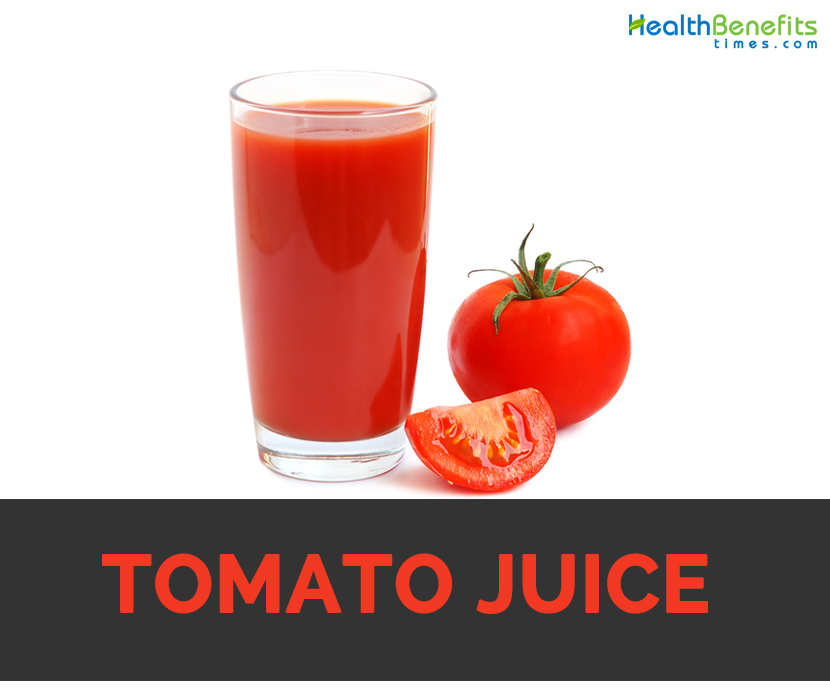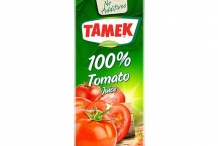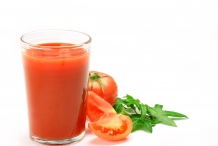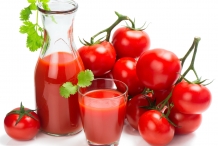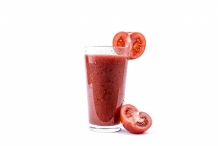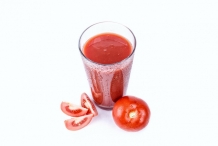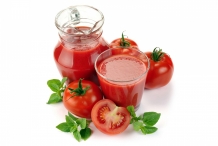| Tomato juice Quick Facts |
| Name: |
Tomato juice |
| Colors |
Light red |
| Shapes |
Liquid |
| Taste |
Sweet |
| Calories |
41 Kcal./cup |
| Major nutrients |
Lycopene (439.20%)
Vitamin C (189.22%)
Vitamin B1 (20.25%)
Vitamin B2 (14.62%)
Vitamin B6 (13.08%)
|
| Health benefits |
Loaded with antioxidants, Support digestion, Prevent blood clotting, Maintains heart health, Supports vision |
Tomato is considered to be the well-known vegetable fruit. It is cooked on its own or combined with potato. This fruit has good nutritive value which has good amounts of Vitamin C and other minerals such as iron, phosphorus and calcium. Due to its low cost, it could be included to daily diet of growing and young children.
Tomato juice is a juice made from tomatoes and used as a beverage or plain or in cocktails such as Michelada or Bloody Mary. The juice is pasteurized and unconcentrated in Canada usually made from rope tomato pulp or whole tomatoes. Skins and stems should be discarded without adding water to final product juice. It may incorporate a citric acid, sweetening agent and salt. It is a variable material that depends on soil, fruit variety and climatic conditions and processing conditions. Withal the quality of tomato juice have little effect on behavior during RO processing. The attempts were made at concentrating tomato juice by RO which was based on eradication of suspended material such as dietary fiber by ultrafiltration or centrifugation focusing clear serum by RO and followed by combining concentrate with insoluble precipitate or concentrate. But this method is not applied commercially.
With the consumption of tomato, there are various misbeliefs such as it causes hypertension but not scientific evidences are found to correlate with that. To the fact, tomatoes have high content of gamma-amino butyric acid which is a compound that helps to lower blood pressure and risk of heart disease. Tomatoes helps to lower blood pressure due to lycopene which is a chemical found in tomato. The extract of tomato has carotenoids such as beta carotene, lycopene and Vitamin E which helps to neutralize free radicals and slow down progression of atherosclerosis.
History
In 1917, tomato juice was served by Louis Perrin at French Lick Springs Hotel in Southern Indiana when he ran out of orange juice and required an immediate substitute. The mixture of squeezed tomatoes, sugar and special sauce which became an imperative success as Chicago businessmen spread world about tomato juice cocktail.
Health Benefits of Tomato Juice
Tomato is a crucial part of international and Indian cuisine. This fruit adds tangy flavor to innumerable delicacies but has beauty and several benefits. Tomato juice is rich in nutrients with low content of fat and calories. A glass of tomato juice offers 74% of daily recommended intake of Vitamin C. It also contains vitamin such as B1, K, B3, B2, B6 and B3.
- Loaded with antioxidants
Tomato juice has high content of antioxidants and is rich in lycopene and beta-carotene responsible for deep red color in tomatoes to lower the chances of developing heart disease. The phytonutrients and antioxidants counteract body from free radicals which causes damage to cells.
- Support digestion
The regular consumption of tomato juice stimulates bowel movement by preventing constipation and promoting digestion. This juice has rich amounts of fiber and acts as mild laxative which could prevent constipation. It helps to prevent the chances of constipation.
- Prevent clotting of blood
Tomatoes contain phytonutrient which prevents abnormal platelet cell clumping beneficial for those who are prone to heart problems. It could be added to daily diet in form of dinner and lunch.
- Healthy heart
Tomatoes contain rich amount of Vitamin C, lycopene, Beta-carotene and Vitamin E which supports heart health. It helps to strengthen walls of blood vessels and eliminate cholesterol from blood.
- Maintain healthy cholesterol
Tomato juice is a good source of fiber that helps to break down bad cholesterol (LDL cholesterol). Presence of niacin has a vital impact on high cholesterol levels.
- Supports vision
Tomato juice is packed with phytonutrients such as lutein, beta-carotene and zeaxanthin with Vitamin C that helps to prevent eye problems such as age related macular degeneration and cataract.
- Speeds up recovery
It has perfect balance of chemicals which assist the body to recover from strenuous exercise. Instead of fizzy energy drinks, choose tomato juice as it is loaded with numerous health benefits.
- Beauty purposes
Tomato juice assist to get rid of counter discoloration of skin, tanning, shrinks open pores, helps to treat acne and regulate secretion of sebum in oily skin. Drink juice regularly to reap all the health benefits that it offers. Tomato juice has iron and vitamin which helps to repair damaged, lifeless and rough hair. Antioxidants halt the cells from being damaged and supports repair of tissue and cells. Tomatoes ensure organs such as skin to remain glowing and healthy all the time.
- Cancer prevention
Tomato juice has carotenoid lycopene which is a provitamin A carotenoid responsible for pink to red color in tomatoes, other foods and pink grapefruit. The processed products of tomato are considered to be the basic dietary lycopene source in United States. Tomatoes and its byproducts possess hypolipidemic, anticarcinogenic and antioxidant properties due to the presence of principal bioactive compound found in it. Antioxidant helps to eradicate free radicals preventing tissue and cell damage and various cancer types. In addition it contains Vitamin C which prevents the chances of oxidation. The anticarcinogenic properties prevent the body from cancer causing carcinogens.
- Liver detoxification
Liver is the largest and crucial organ in the body which purifies bloods and is distributed to the body. Liver counteract with toxins and it requires some detox. Tomatoes are found to detox liver so the tomato juice is considered to improve the liver health.
https://www.youtube.com/watch?v=NA_BLsXHOw4
Precautions
- Tomatoes are acidic in nature so too much consumption of its juice causes acid reflux.
- Some people might experience allergic reactions such as eczema, hives, skin rashes, sneezing, coughing, swollen face, itchy throat and swollen tongue. So people allergic to tomatoes should avoid the juice as well.
- Its excessive intake could lower the blood pressure level abnormally causing hypotension.
- Excess presence of lycopene in body affects prostate gland in males causing pain, cancer and difficulty in passing urine.
- Its high intake could trigger headache, migraines and increase uric acid level resulting gouts.
How to Eat
- In United States, chilled tomato juice is used as an appetizer.
- It is used to prepare tomato juice agar.
- Add it to shake and smoothie.
- Season tomato juice with sugar, pepper or salt and consume as a breakfast juice.
- Mix it with cocktails or mocktails.
- Tomato juice is also used in cooking for making soups and broths, salsas, salad dressings, ketchups and sauces.
References:
https://en.wikipedia.org/wiki/Tomato_juice
https://v8juice.co.uk/blog/12-health-benefits-of-tomato-juice/
http://www.phytojournal.com/archives/2012/vol1issue1/PartA/3.pdf
https://www.sciencedirect.com/topics/food-science/tomato-juice
https://www.lybrate.com/topic/benefits-of-tomato-and-its-side-effects
https://fitlife.expertscolumn.com/side-effects-and-disadvantages-of-eating-tomatoes
https://www.mnn.com/food/recipes/blogs/culinary-uses-for-leftover-juice-from-canned-tomatoes
https://www.tarladalal.com/glossary-tomato-juice-641i
https://food.ndtv.com/health/tomato-juice-benefits-from-improving-digestion-to-boosting-eye-health-and-more-1837819
http://juicinghacks.com/benefits-of-tomato-juice/
https://www.curejoy.com/content/health-benefits-of-tomato-juice/
Comments
comments


